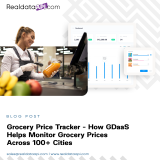


Discover how a Grocery Price Tracker powered by Grocery Data as a Service (GDaaS) helps retailers monitor grocery prices accurately across 100+ cities.
![]()
In a world where consumer expectations evolve daily and inflation impacts every grocery bill, businesses need tools that can scale with demand. The rise of the Grocery Price Tracker is a direct response to the need for real-time, multi-city grocery pricing insights. From retailers and CPG brands to delivery platforms, everyone wants consistent visibility into pricing trends. That’s where Grocery Data as a Service (GDaaS) changes the game. GDaaS helps centralize, standardize, and scale grocery price monitoring across 100+ cities seamlessly. With dynamic dashboards and AI-enabled insights, businesses can react faster to market shifts, optimize pricing, and ensure regional competitiveness.
![]()
Grocery Data as a Service (GDaaS) is a modern data delivery approach that ensures retailers and brands receive clean, structured, and instantly usable grocery datasets across regions. Whether you’re tracking a large supermarket in Chicago or a local store in Portland, GDaaS supports real-time ingestion of prices, stock levels, promotions, and product details. Its robust pipelines update thousands of SKUs daily, powering high-frequency Grocery Price Monitoring for multiple cities at once.
![]()
Grocery Datasets delivered via GDaaS go far beyond basic pricing. These datasets include detailed metadata such as product titles, SKUs, brand names, unit sizes, categories, nutritional facts, images, availability, and promotional tags. This comprehensive view enables granular, apples-to-apples comparisons across retailers and regions.
Retailers and brands can leverage this depth to shape hyper-targeted strategies. Whether you’re running a promotion on almond milk in Dallas or analyzing cereal markdowns in San Francisco, location-based insights ensure relevance and precision. These datasets also empower AI-driven personalization, loyalty apps, in-store pricing tools, and shelf optimization.
![]()
The grocery industry has undergone a significant transformation with the rise of AI-driven pricing models. Traditionally, grocers relied on static pricing or manual competitor checks, but today’s market demands agile, data-backed decisions. Artificial Intelligence (AI) enables retailers to process millions of data points through Grocery Data-as-a-Service (GDaaS) streams, detecting subtle shifts in supply, demand, and regional trends.
For instance, if egg prices unexpectedly surge in Chicago due to supply chain disruptions, AI models analyze this anomaly instantly. Retailers receive real-time alerts, allowing them to adjust prices, update promotions, or shift inventory between stores. This reduces profit loss and strengthens competitiveness.
![]()
The effectiveness of any Grocery Price Tracker hinges on one critical component: data. To track dynamic pricing across thousands of SKUs, categories, and geographies, grocers and analytics platforms depend on Grocery Data Scraping Services to collect real-time, structured pricing intelligence. Platforms like Real Data API act as the data extraction backbone, scraping websites, mobile apps, and third-party e-commerce portals for granular grocery pricing signals.
Real-time grocery data scraping also powers automated alerts, where sudden price changes, out-of-stock notices, or competitor promotions trigger business logic—like re-pricing, promotion matching, or inventory redistribution. With multiple updates per day across markets, grocers gain an edge in hypercompetitive environments where even small pricing delays can lead to margin erosion.
![]()
In the world of grocery retail, price tracking isn’t just about collecting data—it’s about making meaningful, accurate comparisons. But comparing the same product across multiple retailers is a complex task. One retailer may list “Organic Brown Eggs – 12 count,” while another lists “12pk Org Brn Eggs.” Without intelligent mapping, price comparisons become unreliable. This is where Product Matching AI becomes essential.
![]()
Real Data API combines cutting-edge Grocery Data Scraping Services, AI-based validation, and clean Grocery Datasets to provide scalable GDaaS solutions. Our platform supports daily price monitoring across 100+ cities, includes pre-integrated Product Matching AI, and powers real-time dashboards tailored for retailers, brands, and eCommerce platforms. With seamless integration, granular data fields, and enterprise SLAs, we help you build the most robust Grocery Price Tracker in your category.
Whether you manage pricing for 10 stores or analyze trends across 100 cities, the right data infrastructure can redefine your outcomes. Let Real Data API empower your team with real-time insights that keep you ahead of price wars, demand shifts, and market trends. Ready to scale your pricing visibility? Contact Real Data API for a custom Grocery Price Tracker solution built for 100+ cities!
